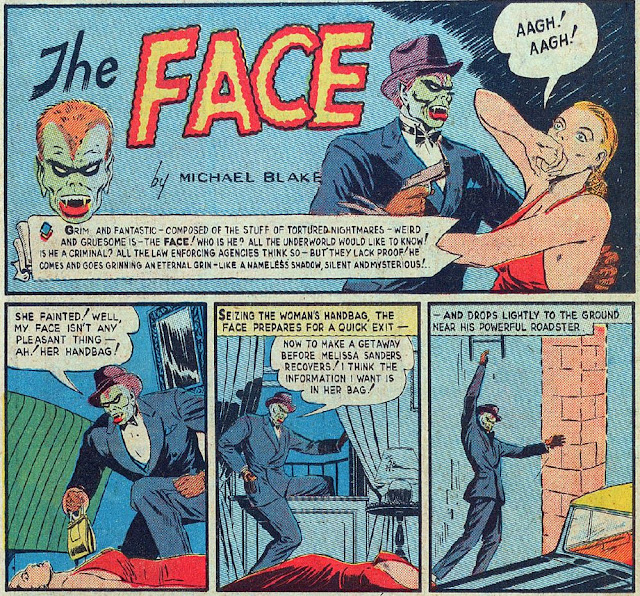All Columbia Comic Corporation edition!
Skyman:
Skyman (properly the Skyman but it just doesn't scan for me) is a pilot hero, normally a ho-hum sort of character for me. But between his sci-fi super plane (the Wing), his blood-freezing stun ray (the Stasimatic) and his cool on-the-edge-of-being-too-busy costume there's just enough super-hero peanut butter mixed in with the pilot chocolate to make it appealing (bonus running list of Skyman's super science: atomic explosives, invisible glass phonograph, disitegrator ray, explosives-detonating ray and a ray that fuses gun barrels shut)
After a few issues we learn that the Skyman is actually Allan Turner, wealthy good-for-nothing playboy who lost his parents to a plane crash when he was a child. If the Bruce Wayne parallel was 1:1 he would have grown up to become a noted slayer of planes, but that's a villain's origin. Instead, Allan Turner dresses up as a plane to fight criminals. It doesn't make quite as much narrative sense as Batman does but it's probably more fun to read than the other way around.
Early Skyman also might just hold the record for the most overinflated torso in comics outside of parody characters. He gets a bit more proportional eventually but for a while there you're concerned for his ability to live a normal life.
the Face:
The Face, like a lot of early comics heroes, draws a lot of elements from the pulps: a tuxedo-clad hero drives around in a souped up roadster fighting crime with his fists and an automatic - a pretty regular early super-guy. Even his secret identity of Tony Trent, radio station owner/ radio announcer is in the pulp-adjacent character wheelhouse.
It was very exciting to me when I realized that the Face's face is frequently referred to as a rubberoid mask, my favourite term for the kind of masks that only exist in comic books - perfectly realistic and naturalistic but also very easy to don and doff. This particular mask was made specially for Tony Trent by someone whose other major characteristic is being dead, which is apparently a combination that makes Trent feel quite jolly.
Weirdly, in Big Shot Comics 006, the Face has a new, slightly less grotesque mask. No word on where he got this one but he goes back to the original pretty quickly.
Marvelo, Monarch of Magicians:
Created by Fred Guardineer, who also created Zatara over at DC Comics, Marvelo is... extremely similar to Zatara. Aside from their different approaches to dressing like a stage magician, I'd say that there are two slight differences between the characters:
1. Rather than speaking backward to cast spells, Marvelo shouts "Kalora!" as an all-purpose magic word.
2. Marvelo's manservant Zee is just a hair more racist than Zatara's manservant Tong. It's pretty close but I reckon Zee takes it.
Big Shot Comics 017 reveals that Marvelo is the son of the ruler of the generically foreign South Pacific island of Brahama (hell on autocorrect). This doesn't seem to have anything to do with him being a magic man but it's nice to know. (Big Shot Comics 001, 1940)
the Cloak:
Jeff Cardiff, Spy Chief was a feature in Big Shot Comics from issue 1 (well, it was Jeff Cardiff, Spy-Master for the first issue or two but the point stands) with all kinds of foiled plots and plans and spies of both the vaguely fascist and vaguely communist varieties. In Issue 15, however, the spies adopt the reasonable policy of attempting to shoot on sight the man who has foiled so many of their plans and a wounded Jeff Cardiff goes to recuperate at his brother's house.
Long story short, Jed Cardiff is a coal magnate with a collection of "adventure curios", including the namesake cloak of Revolutionary War-era costumed spy the Cloak and it being 1941 and a comic book, Jeff immediately adopts the Cloak identity as his own. It's a fairly basic costumed hero shtick but I appreciate the effort and it's always nice to see a more elaborate cape and cowl getup now and then. (Big Shot Comics 015, 1941)
The original Cloak eventually shows up in a flashback and it turns out that his impact on the history of the American Revolution is only slightly less impactful than Superboy's in the 1949 story in which he goes back in time and takes part in about half the major events of the war. I must say that I do love a retcon of a historical event. (Big Shot Comics 021, 1942)

















No comments:
Post a Comment